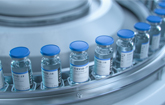DUBLIN, Oct. 21, 2020 /PRNewswire/ -- The "Antibody Discovery Services and Platforms Market (3rd Edition) by Service Offered, by Antibody Discovery Method, by Nature of Antibody Generated and by Key Geographies: Industry Trends and Global Forecasts, 2020-2030" report has been added to ResearchAndMarkets.com's offering.
"Antibody Discovery: Services and Platforms Market (3rd Edition), 2020-2030" report features an extensive study on the current market landscape, offering an informed opinion on the likely evolution in this industry over the next ten years.
The study underlines an in-depth analysis of the antibody discovery technologies and services that assist in the development of antibody therapeutics.
One of the key objectives of the report was to estimate the existing market size and potential future opportunities for antibody discovery platforms and services, for the next decade. Based on parameters, such as the overall R&D expenditure available to CROs, percentage of R&D expenses incurred in each discovery step, and outsourcing profile, we have provided an informed estimate of the likely evolution of the antibody discovery services market in the mid to long term, for the time period 2020-2030.
With close to 80 monoclonal antibodies approved till date, and over 550 molecules in the clinical pipeline, antibody based pharmacological interventions have become an important part of the biopharmaceutical industry. In fact, they are presently estimated to constitute the largest class of biologics in the industry.
Examples of recently approved monoclonal antibody products include (in reverse chronological order) Adakveo (November 2019), Beovu (October 2019), SKYRIZIT (April 2019) and EVENITYT (April 2019). These molecules have high target specificities and favorable safety profiles.
Further, given the success of monoclonal antibodies, research on other novel antibody formats, such as bispecific antibodies, antibody drug conjugates (ADCs) and antibody fragments, has also gained traction.
The report also features the likely distribution of the current and forecasted opportunity within antibody discovery services market across
- The various steps involved in antibody discovery process (antigen designing, hit generation, lead selection, lead optimization and lead characterization)
- Antibody discovery methods (hybridoma based, library-based, single cell-based, transgenic animal-based, animal-based and others
- The nature of antibody generated (whether human/ fully human or not)
The report features detailed transcripts of interviews held with the following industry stakeholders:
- Tracey Mullen (Chief Executive Officer, Abveris Antibody)
- Lisa Delouise (Founder and Chief Technology Officer, Nidus Biosciences)
- Mark Kubik (Chief Business Officer, AvantGen)
- Chun-Nan Chen (Chief Executive Officer and Chief Scientific Officer, Single Cell Technology)
- Giles Day (Co-Founder and Chief Executive Officer, Distributed Bio)
- Kevin Heyries (Co-Founder and Lead of Business Development Strategy, AbCellera)
- Sanjiban K Banerjee (Director, AbGenics Life Sciences)
- Ignacio Pino (Chief Executive Officer and President, CDI Laboratories)
- Jeng Her (Chief Executive Officer, AP Biosciences)
- Thomas Schirrmann (Chief Executive Officer and General Manager, YUMAB)
- Debra Valsamis (Business Development Associate, Antibody Solutions)
- Christel Iffland (Vice President, Ligand Pharmaceuticals)
- Aaron Sato (former Chief Scientific Officer, LakePharma)
Key Topics Covered:
1. PREFACE
2. EXECUTIVE SUMMARY
3. INTRODUCTION
3.1. Chapter Overview
3.2. Structure of Antibodies
3.3. History of Development
3.4. Antibody Isotypes
3.5. Mechanism of Action of Antibodies
3.6. Classification of Antibodies
3.6.1. Monoclonal Antibodies
3.6.2. Polyclonal Antibodies
3.6.3. Bispecific Antibodies
3.7. Applications of Antibodies
4. ANTIBODY DISCOVERY PROCESS AND METHODS
4.1. Chapter Overview
4.2. Antibody Discovery Process
4.2.1. Target Selection and Validation
4.2.2. Hit Generation
4.2.3. Lead Selection
4.2.4. Lead Optimization
4.2.4.1. Humanization
4.2.4.2. Affinity Maturation
4.2.4.3. Fc Engineering
4.2.5. Lead Characterization
4.2.6. Candidate Selection
4.3. Antibody Discovery Methods
4.3.1. Hybridoma Method
4.3.2. In vitro Display Method
4.3.2.1. Phage Display
4.3.2.2. Yeast Display
4.3.2.3. Ribosomal Display
4.3.3. Transgenic Animal-Based Method
4.3.4. Single B Cell-Based Method
4.3.5. Advantages and Disadvantages of Existing Antibody Discovery Techniques
4.4. Evolution of Monoclonal Antibodies
4.4.1. Fully Human Monoclonal Antibodies
5. ANTIBODY DISCOVERY SERVICE PROVIDERS: CURRENT MARKET LANDSCAPE
5.1. Chapter Overview
5.2. Antibody Discovery Service Providers: List of Industry Players
5.2.1. Analysis by Year of Establishment
5.2.2. Analysis by Company Size
5.2.3. Analysis by Location of Headquarters
5.2.4. Analysis by Type of Service Offered
5.2.5. Analysis by Type of Antibody Discovery Method
5.2.6. Grid Representation: Analysis by Type of Service Offered, Type of Antibody Discovery Method and Company Size
5.2.7. Analysis by Animal Model Used
5.2.8. Analysis by Type of Antibody Discovered
5.2.9. Analysis by Type of Antibody Discovery Method and Type of Antibody Discovered
5.2.10. Analysis by Purpose of Antibody Discovery
5.2.11. Analysis by Type of Antibody Discovery Method and Purpose of Antibody Discovery
6. COMPANY COMPETITIVENESS ANALYSIS
6.1. Chapter Overview
6.2. Methodology
6.3. Key Parameters
6.4. Competitiveness Analysis: Antibody Discovery Service Providers
7. COMPANY PROFILES: ANTIBODY DISCOVERY SERVICE PROVIDERS
7.1. Chapter Overview
7.2. Antibody Discovery Service Providers in North America
7.2.1. Abwiz Bio
7.2.2. Aragen Bioscience (A GVK BIO Company)
7.2.3. Distributed Bio
7.2.4. Integral Molecular
7.2.5. LakePharma
7.3. Antibody Discovery Service Providers in Europe
7.3.1. Abzena
7.3.2. ImmunoPrecise Antibodies
7.3.3. PX'Therapeutics (Subsidiary of Aguettant Pharmaceutical Group)
7.4. Antibody Discovery Service Providers in Asia-Pacific
7.4.1. ChemPartner
7.4.2. Viva Biotech
7.4.3. WuXi Biologics
8. ANTIBODY DISCOVERY TECHNOLOGIES: CURRENT MARKET LANDSCAPE
8.1. Chapter Overview
8.2. Antibody Discovery Platform Providers: List of Industry Players
8.2.1. Analysis by Year of Establishment
8.2.2. Analysis by Company Size
8.2.3. Analysis by Location of Headquarters
8.2.4. Analysis by Type of Antibody Discovered
8.3. Antibody Discovery: List of Technologies and Platforms
8.3.1. Analysis by Type of Antibody Discovery Method
8.3.2. Analysis by Type of Antibody Discovery Method and Location of Headquarters
8.3.3. Analysis by Animal Model Used
8.3.4. Analysis by Patent Availability
9. TECHNOLOGY COMPETITIVENESS ANALYSIS
9.1. Chapter Overview
9.2. Methodology
9.3. Key Parameters
9.4. Technology Competitiveness Analysis: Antibody Discovery Platforms
9.4.1 Competitiveness Analysis: Library Based Antibody Discovery Platforms
9.4.2. Competitiveness Analysis: Single Cell Based Antibody Discovery Platforms
9.4.3. Competitiveness Analysis: Transgenic Animal Based Antibody Discovery Platforms
9.4.4. Competitiveness Analysis: Other Antibody Discovery Platforms
10. COMPANY PROFILES: ANTIBODY DISCOVERY PLATFORM PROVIDERS
10.1. Chapter Overview
10.2. ImmunoPrecise Antibodies
10.2.1. Company Overview
10.2.2. Financial Information
10.2.3. Portfolio of Antibody Discovery Platforms
10.2.3.1. AbthenaT
10.2.3.2. B cell SelectT
10.2.3.3. DeepDisplayT
10.2.3.4. ModiFuseT
10.2.3.5. ModiPhageT
10.2.3.6. ModiSelectT
10.2.3.7. ModiTuneT
10.2.4. Recent Developments and Future Outlook
10.3. Harbour BioMed
10.3.1. Company Overview
10.3.2. Portfolio of Antibody Discovery Platforms
10.3.2.1. H2L2 Platform
10.3.2.2. HCAb Platform
10.3.3. Recent Developments and Future Outlook
10.4. Kymab
10.4.1. Company Overview
10.4.2. Portfolio of Antibody Discovery Platforms
10.4.2.1. KymouseT
10.4.2.2. IntelliSelect
10.4.3. Recent Developments and Future Outlook
10.5. Ligand Pharmaceuticals
10.5.1. Company Overview
10.5.2. Financial Information
10.5.3. Portfolio of Antibody Discovery Platforms
10.5.3.1. OmniAb
10.5.3.1.1. OmniChicken
10.5.3.1.2. OmniClicT
10.5.3.1.3. OmniFlic
10.5.3.1.4. OmniMouse
10.5.3.1.5. OmniRat
10.5.4. Recent Developments and Future Outlook
10.6. MorphoSys
10.6.1. Company Overview
10.6.2. Financial Information
10.6.3. Portfolio of Antibody Discovery Platforms
10.6.3.1. arYla Technology
10.6.3.2. HuCAL Technology
10.6.3.3. Ylanthia Technology
10.6.4. Recent Developments and Future Outlook
11. REGIONAL CAPABILITY ANALYSIS
12. PARTNERSHIPS AND COLLABORATIONS
12.1. Chapter Overview
12.2. Partnership Models
12.3. List of Partnerships and Collaborations
13. FUNDING AND INVESTMENT ANALYSIS
13.1. Chapter Overview
13.2. Types of Funding
13.3. Antibody Discovery Service and Platform Providers: Funding and Investment Analysis
13.4. Concluding Remarks
14. ANTIBODY DISCOVERY SERVICES: MARKET FORECAST
14.1. Chapter Overview
14.2. Forecast Methodology
14.3. Global Antibody Discovery Services Market, 2020-2030
14.4. Global Antibody Discovery Services Market: Distribution by Steps Involved in Antibody Discovery Process, 2020-2030
14.5. Global Antibody Discovery Services Market: Distribution by Antibody Discovery Method, 2020-2030
14.6. Global Antibody Discovery Services Market: Distribution by Nature of Antibody Generated, 2020-2030
14.7. Global Antibody Discovery Services Market: Distribution by Region, 2020-2030
15. ANTIBODY DISCOVERY TECHNOLOGIES: MARKET FORECAST
15.1. Chapter Overview
15.2. Key Assumptions
15.3. Forecast Methodology
15.4. Global Antibody Discovery Platforms Market, 2020-2030
15.5. Global Antibody Discovery Platforms Market: Distribution by Region, 2020-2030
16. CASE IN POINT: DRUG DISCOVERY PROCESSES OF TOP SELLING ANTIBODIES
16.1. Chapter Overview
16.2. Humira (Adalimumab)
16.2.1. Drug Overview
16.2.2. Discovery Process and Method
16.2.3. Historical Sales
16.3. Keytruda (Pembrolizumab)
16.4. Herceptin (Trastuzumab)
16.5. Avastin (Bevacizumab)
16.6. Rituxan (Rituximab)
17. CASE STUDY: ANTIBODY HUMANIZATION AND AFFINITY MATURATION
17.1. Importance of Antibody Humanization and Affinity Maturation
17.2. Antibody Humanization and Affinity Maturation Service and Platform Providers: Market Landscape
17.3. Antibody Humanization: Publication Analysis
17.3.1. Publication Analysis: Year-Wise Trend
17.3.2. Publication Analysis: Key Journals
17.3.3. Publication Analysis: Distribution by Animal Model Used
17.3.4. Publication Analysis: Distribution by Method Used for Humanization
17.4. Antibody Humanization Service and Platform Providers: SWOT Analysis
18. FUTURE GROWTH OPPORTUNITIES IN ANTIBODY DISCOVERY
18.1. Chapter Overview
18.2. Anticipated Shift from Monoclonal Antibodies to Other Novel Formats
18.3. Technological Advancements to Overhaul Conventional Antibody Discovery Processes
18.4. Transition to CADD-based Approaches to Help Achieve Better Operational Efficiencies
18.5. Rising Demand for Antibody-based Treatment Options across Non-Oncology Indications
18.6. Growing Market Opportunities in the Asia-Pacific Region
18.7. Expected Increase in Number of Collaborations and Licensing Activity
18.8 Concluding Remarks
19. EXECUTIVE INSIGHTS
20. CONCLUDING REMARKS
20.1. Chapter Overview
20.2. Key Takeaways
For more information about this report visit https://www.researchandmarkets.com/r/62t5xx
Research and Markets also offers Custom Research services providing focused, comprehensive and tailored research.
Media Contact:
Research and Markets
Laura Wood, Senior Manager
[email protected]
For E.S.T Office Hours Call +1-917-300-0470
For U.S./CAN Toll Free Call +1-800-526-8630
For GMT Office Hours Call +353-1-416-8900
U.S. Fax: 646-607-1907
Fax (outside U.S.): +353-1-481-1716
SOURCE Research and Markets

Related Links
http://www.researchandmarkets.com
WANT YOUR COMPANY'S NEWS FEATURED ON PRNEWSWIRE.COM?
Newsrooms &
Influencers
Digital Media
Outlets
Journalists
Opted In





Share this article